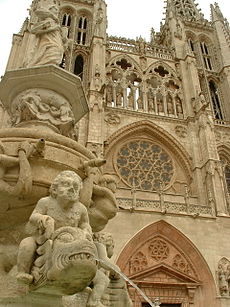
The Archdiocese of Toledo is a Latin Church archdiocese of the Catholic Church located in Spain. They are also the Primates of Spain. It was, according to tradition established in the 1st century by James the Great and was elevated to an archdiocese in 313 after the Edict of Milan. The incumbent Metropolitan Archbishop also bears the title Primate of Spain and since 1937 the title General Vicar of the Armies

The Archdiocese of Santiago de Compostela is a Latin Church archdiocese of the Catholic Church in Spain. It is the most senior of the five districts into which the church divides the region of Galicia.

The Diocese of Ourense is one of five Latin Church dioceses of the Catholic Church in Galicia, northwestern Spain. The Bishop of Ourense has his cathedra in the Catedral de la Virgen Madre de los Milagros in Ourense and his jurisdiction covers all the 28 districts and 735 parishes of the Province of Ourense.

The Metropolitan Archdiocese of Seville is a Latin Church archdiocese of the Catholic Church in Seville, Spain. The Diocese of Seville was founded in the 3rd century. It was raised to the level of an archdiocese in the 4th century. The current archbishop is José Ángel Saiz Meneses. It has the suffragan dioceses of:

The Roman Catholic Archdiocese of Lima is part of the Catholic Church in Peru which enjoys full communion with the Holy See. The Archdiocese was founded as the Diocese of Lima on 14 May 1541. The diocese was raised to the level of a metropolitan archdiocese by Pope Paul III on 12 February 1546. One of its archbishops was the saint Torribio Mogrovejo.

The Archdiocese of Granada is a Latin ecclesiastical province of the Catholic Church in Spain. Originally the Diocese of Elvira from the 3rd century through the 10th, it was re-founded in 1437 as the diocese of Granada and was elevated to the rank of a metropolitan archdiocese by Pope Alexander VI on 10 December 1492. Its suffragan sees are Almería, Cartagena, Guadix, Jaén and Málaga.

The Archdiocese of Mérida–Badajoz is a Latin Church ecclesiastical territory of the Catholic Church in Spain, created in 1255. Until 1994, it was known as the Diocese of Badajoz.

The Diocese of Palencia is a Latin diocese of the Catholic Church located in the city of Palencia in the ecclesiastical province of Burgos, Spain.

The Diocese of Cartagena is a Latin Church diocese of the Catholic Church in the city of Cartagena in the ecclesiastical province of Granada in Spain.

The Diocese of Jaén is a Latin Church diocese of the Catholic Church in the city of Jaén in the ecclesiastical province of Granada in Spain.

The Diocese of Coria-Cáceres is a Latin Church diocese of the Catholic Church located in the cities of Coria and Cáceres in the ecclesiastical province of Mérida–Badajoz in Spain.

The Diocese of León is a Latin Church diocese of the Catholic Church located in the city of León in the ecclesiastical province of Oviedo in Spain.

The Diocese of Calahorra and La Calzada-Logroño ) is a Latin diocese of the Catholic Church located in the cities of Calahorra, Santo Domingo de la Calzada, and Logroño in the ecclesiastical province of Pamplona y Tudela in Spain.

The Diocese of Córdoba is a Latin Church diocese of the Catholic Church located in the city of Córdoba in the ecclesiastical province of Sevilla in Spain. Bishop Demetrio Fernández González is the current bishop of Cordoba.

The Roman Catholic Diocese of Cuenca is a Latin Church diocese located in the city of Cuenca in the ecclesiastical province of Toledo in Spain.

The Diocese of Sigüenza-Guadalajara is a Latin Church diocese of the Catholic Church located in the cities of Sigüenza and Guadalajara, Spain in the ecclesiastical province of Toledo in Spain. It is in the located in the secular Spanish province of Guadalajara in Castile, central Spain. It is bounded on the north by Soria, on the east by Zaragoza and Teruel, on the south by Cuenca and on the west by Guadalajara and Segovia.

The Diocese of Ciudad Rodrigo is a Latin diocese of the Catholic Church, located in the city of Ciudad Rodrigo in the ecclesiastical province of Valladolid.

The Diocese of Salamanca is a Latin diocese of the Catholic Church located in the city of Salamanca in the ecclesiastical province of Valladolid in Spain.

The Diocese of Segovia is a Latin diocese of the Catholic Church located in the city of Segovia in the ecclesiastical province of Valladolid in Spain.

The Diocese of Zamora is a Latin diocese of the Catholic Church in the city of Zamora in the ecclesiastical province of Valladolid in Spain.






















